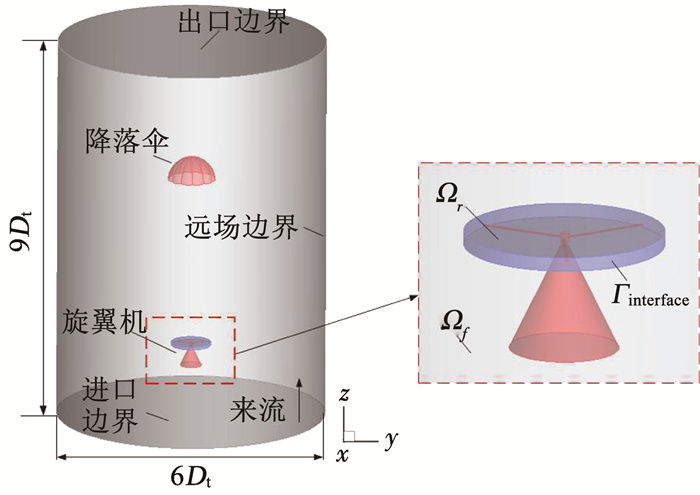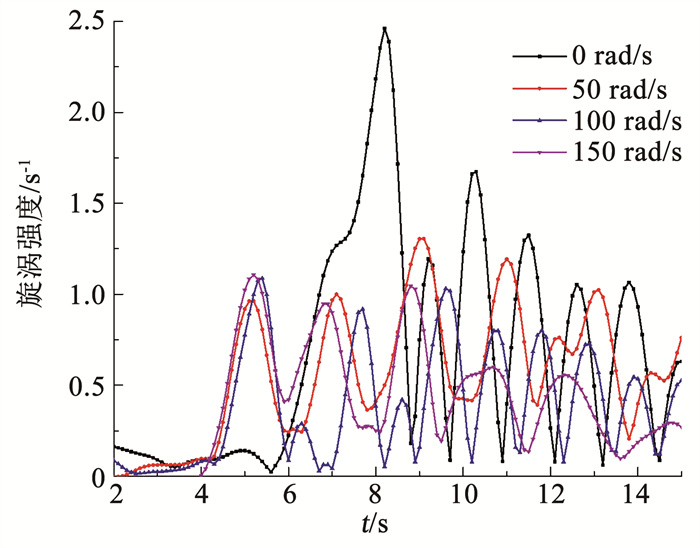2. 南京航空航天大学 航空学院, 南京 210016;
3. 北京空间机电研究所, 北京 100094
2. College of Aerospace Engineering, Nanjing University of Aeronautics and Astronautics, Nanjing 210016, China;
3. Beijing Institute of Space Mechanics & Electricity, Beijing 100094, China
自旋翼无人机因其飞行性能好、不受地形限制等优点, 被广泛用于地质探测、搜救侦查以及科学研究等领域。但是, 当在飞行过程中出现故障时, 可能会发生严重的安全事故甚至坠毁。目前, 已经广泛采用降落伞对固定翼无人机进行减速回收[1], 而对旋翼机回收的研究工作较少。当失控状态的旋翼机处于垂直下降时, 旋翼产生的旋转流场[2]加剧了前体尾流的非定常变化, 导致流向降落伞的流场变化紊乱.为探究旋翼扰动下物伞系统的流场特性以及伞衣气动性能变化, 需要对旋翼机/降落伞的非定常复合流场展开深入的研究。
目前, 旋翼流场的研究主要通过风洞试验和数值模拟, 风洞试验能够真实反映旋翼的工作状态[3-4], 通过控制旋翼的状态参数获得准确的试验数据, 但存在洞壁效应[5]、实验数据可重复性差[6]、成本代价高等问题。随着计算流体力学(computational fluid dynamics, CFD)的发展, 数值模拟逐渐成为研究旋翼流场的重要手段, 该方法通过直接求解流场控制方程(Euler方程或Navier-Stokes方程)[7-8], 能真实还原流场的细节变化, 具备较高的求解精度。如文献[9-11]采用CFD方法对悬停状态下的旋翼流场进行了数值模拟, 得到了桨叶附近真实的流场细节变化; 文献[12-13]观察到前飞状态下的旋翼桨尖涡, 分析了旋翼尾迹涡和下洗流的非定常流场特征变化; 文献[14]发现旋翼垂直下降流场会出现涡环状态, 随下降速度增加旋翼下洗流逐渐上移直至被来流抵消。
众多学者也广泛开展了旋翼复合流场的数值研究, 如文献[15-17]对倾转旋翼机/机翼的复合流场进行了CFD数值模拟, 精确捕捉到了流场的旋涡结构, 观察到旋翼/机身产生的“喷泉效应”[15-16]现象; 文献[18-20]对旋翼与舰船的复合流场进行数值模拟, 发现旋翼绕流与舰船尾流发生叠加[18], 会产生旋涡、回流、分离[19]等多种复杂的流动形式, 在侧风的掺混下进一步形成涡流紊乱区, 涡流区范围和气流下洗明显增加, 甲板流场变化极不稳定[20]。目前, 对旋翼复合流场的数值研究还有很多[21-22], 但旋翼机/降落伞非定常复合流场的研究工作却很少。
本文基于PISO(pressure implicit split operator)算法对旋翼机/降落伞复合流场展开非定常数值计算, 为提高网格更新效率, 采用了不同变形尺度网格分类处理的思路。随后, 研究了旋翼转动对物伞系统流场分布和旋涡演变的非定常影响, 分析了不同旋翼转速下流场特性参数和降落伞气动特性的变化情况, 为进一步探究旋翼机与降落伞的气动干扰提供一定参考。
1 计算方法 1.1 数值方法及湍流模型本文基于有限体积法采用MUSCL(monotone Upstream-centered schemes for conservation laws)三阶格式进行流场方程离散, 为提高瞬态计算精度并加速收敛采用了PISO算法, 压力插值选择Standard格式, 为有效处理瞬态计算伪扩散问题选择Green-gauss Node-based格式梯度插值。边界条件采用速度进口和压力出口, 远场为对称边界条件, 伞衣面以及旋翼机(包括前体和旋翼)为无滑移边界条件, 旋转区域Ωr和自由流区域Ωf的交界面Γinterface为Ineterface边界条件。
为获得精细的流场结构、有效求解固壁绕流问题, 本文计算采用了标准壁面函数法(standard wall functions), 湍流模型选择Realizable k-ε两方程模型, 其控制方程为
| $ \left\{ \begin{array}{l} \frac{{\partial \left( {\rho k} \right)}}{{\partial t}} + \frac{{\partial \left( {\rho k{u_i}} \right)}}{{\partial {x_i}}} = \frac{\partial }{{\partial {x_j}}}\left[ {\left( {\mu + \frac{{{\mu _t}}}{{{\sigma _k}}}} \right)\frac{{\partial k}}{{\partial {x_j}}}} \right] + \\ {G_k}-\rho \varepsilon \\ \frac{{\partial \left( {\rho \varepsilon } \right)}}{{\partial t}} + \frac{{\partial \left( {\rho \varepsilon {u_i}} \right)}}{{\partial {x_i}}} = \frac{\partial }{{\partial {x_j}}}\left[ {\left( {\mu + \frac{{{\mu _t}}}{{{\sigma _\varepsilon }}}} \right)\frac{{\partial \varepsilon }}{{\partial {x_j}}}} \right] + \\ \rho {C_1}E\varepsilon -\rho {C_2}\frac{{{\varepsilon ^2}}}{{k + \sqrt {\nu \varepsilon } }} \end{array} \right. $ | (1) |
式中:经验系数
迭代格式的时间推进方法在每个时间步内都要对流场网格进行更新, 以确保网格变形后能够继续满足计算要求。为了提高网格更新效率, 本文将Diffusion Smoothing和Remeshing两种网格更新方法相结合, 对不同变形尺度的网格进行分类处理:对小幅运动的网格采用Diffusion Smoothing[23]方法通过求解扩散方程得到位移后网格节点的位置, 但该方法未改变网格拓扑结构, 在大变形区域容易产生负体积, 此时引入Remeshing[23-24]更新方法进行弥补, 对超过设定的歪斜率或尺寸阈值的网格进行标记, 并局部重新划分这些网格单元, 技术途径如图 1所示。

|
图 1 本文网格更新技术途径 Fig. 1 Technical procedure of mesh updating model |
Diffusion Smoothing方法通过求解以下控制方程来获得网格节点的位置:
| $ \left\{ \begin{array}{l} \nabla \cdot \left( {\gamma \;\nabla \mathop u\limits^ \to } \right) = 0\\ \mathop {{x_2}}\limits^ \to = \mathop {{x_1}}\limits^ \to + \mathop {u}\limits^ \to \Delta t \end{array} \right. $ | (2) |
式中:u为网格运动速度, γ=(1/dα)为扩散系数(α取1.5), d为正则化后的网格节点与边界的距离, x2为下一个时间步网格节点的位置。
2 研究对象及数值模型 2.1 研究对象及计算工况本文的研究对象由三桨叶圆锥形旋翼机(桨叶角为0°)和半球形降落伞组成, 其外形及几何参数关系如图 2所示。不考虑伞衣的织物透气性和伞绳对流场的影响, 物伞系统结构参数、来流及计算工况见表 1、2。

|
图 2 旋翼机- 降落伞系统三维模型 Fig. 2 3D model of rotorcraft-parachute system |
| 表 1 物伞系统结构参数 Tab. 1 Structure parameters of rotorcraft-parachute system |
| 表 2 来流条件及计算工况 Tab. 2 Free flow and calculation conditions |
本文建立直径6Dt、高9Dt(Dt为伞衣投影直径)的圆柱形流场模型, 如图 3所示。流场计算域分为两个部分:旋转流域Ωr和自由流域Ωf。旋翼位于旋转流域, 其尺寸为直径2.2l、高0.15l的圆柱形流场, 其他部分均处于自由流域, 两个流域交界面为Γinterface。

|
图 3 计算域和物伞系统 Fig. 3 Computational domain and rotorcraft-parachute system |
旋转流域在每个时间步内均涉及网格的移动和更新, 分别对旋转流域和自由流域划分网格, 并将两流域交界面Γinterface上的网格节点(如Q1、Q2和Q3)进行连接, 保证了两个流域边界信息传递的连续性, 如图 4所示。计算采用了适应性良好的三角形网格, 为了增加计算精度和捕捉流场细节, 对旋翼机和降落伞大梯度复杂流域的网格进行加密, 网格总数为118万。

|
图 4 物伞系统数值模型 Fig. 4 Numerical model of rotorcraft-parachute system |
本文首先对旋翼转速ω=0 rad/s时物伞系统的绕流流场进行了数值计算, 稳定时伞衣的平均阻力系数为0.71, 与文献[25]中半球形伞阻力系数0.75的相对误差仅为5.33%, 说明本文计算方法具有较好的准确性。
随后, 对旋翼转速ω=50 rad/s时采用了4种不同网格密度的流场进行数值计算, 其稳定后的平均阻力系数CD见表 3。从表 3可以看出:随网格数增加, 降落伞平均阻力系数CD增加, 当网格数达到118万时, 平均阻力系数增加延缓, 但是计算时长严重增加, 因此综合考虑, 本文采用118万的网格模型进行数值计算。
| 表 3 数值结果对比 Tab. 3 Comparison of numerical results |
本文选取旋翼转速ω=0 rad/s和50 rad/s两种工况下的流场分布和旋涡演变进行分析。图 5为计算稳定(t=15 s)旋翼机- 降落伞系统的流场分布, 可以看出:高速转动的桨叶直接改变了旋翼机的尾流结构, 将其分割成两个扰动区域, 旋涡中心由Q分裂为Q1和Q2, 尾流低压区P1也以桨叶平面P为分界面形成两个低压区; 桨叶运动迫使旋翼机尾流向伞衣入口延伸, 旋涡中心Q1较Q向上移动; 旋翼机尾流低压区P1长度增加, 伞衣入口正压区P2长度减小且呈不对称分布; 旋翼机尾流的低动压区V完全移至旋翼上方, 缩短了到伞衣入口的距离。

|
图 5 旋翼机- 降落伞系统流场分布(t=15 s) Fig. 5 Flowfield distribution of rotorcraft-parachute system (t=15 s) |
图 6为计算稳定阶段旋翼机- 降落伞系统的尾涡变化情况, 可以看出:旋翼机和伞衣表面时刻出现旋涡的生成与脱离, 旋翼转动导致前体尾流区的涡量呈不对称分布, 干扰了前体尾涡的形成, 前体尾流中的旋涡数量明显减少。同时, 前体尾流的负涡量区在旋翼扰动下逐渐后移, 与伞衣入口的负涡量区相连通, 促进了伞衣尾涡的脱离, 伞衣尾流中的旋涡数量明显增多。

|
图 6 物伞系统旋涡变化(上:ω=0 rad/s; 下:ω=50 rad/s) Fig. 6 Variation of vortex of rotorcraft-parachute system (Top: ω=0 rad/s; Bottom: ω=50 rad/s) |
图 7为物伞系统涡量Q的等值面分布, 从图 7(a)可以看出, 由于旋翼机前体和伞衣的钝体效应[20], 来流绕流物伞表面后形成表面涡流区VS-1和VS-2, 旋翼转动扰乱了旋翼机表面涡流区VS-1的涡量分布, 形成旋转涡流区VS-1R和表面涡流区VS-1S。旋翼机表面涡流区VS-1继续向后发展, 生成脱落涡流区VB进入流场, 如图 7(b)所示, 而旋翼转动时的脱落涡流区VB明显小于无旋翼转动, 旋翼扰乱了前体表面涡流分布后形成旋转涡流区, 将前体尾涡“打碎”, 导致前体尾流中的脱落涡流区范围变小, 进入伞衣的尾涡涡流随之减少, 伞衣表面涡流区VS-2范围变小。

|
图 7 物伞系统涡量等值面分布(t=15 s) Fig. 7 Vorticity isosurface distribution of rotorcraft-parachute system (t=15 s) |
图 8为不同旋翼转速下伞衣入口处旋涡强度的径向分布, 可以看出:由于分离流动, 旋涡强度在伞衣裙边(R=±2.5 m)处的变化最为剧烈, 此时曲线峰值较高且变化梯度较大, 在伞衣内部变化则较为平缓, 随旋翼转速增加, 旋涡强度曲线的峰值减小, 径向方向的旋涡强度逐渐减弱。

|
图 8 伞衣入口处旋涡强度的径向分布(t=15 s) Fig. 8 Radial distribution of vorticity magnitude at the entrance of canopy (t=15 s) |
图 9为伞衣入口处旋涡强度随时间的变化, 可以看出:由于旋翼机尾涡的周期性影响, 伞衣入口处的旋涡强度随时间发生着波动, 随旋翼转速增加, 旋翼对前体尾涡的扰乱作用加强, 加速了涡流区的黏性耗散, 进入流场的尾涡涡量减少, 伞衣入口处的旋涡强度逐渐减弱。

|
图 9 伞衣入口旋涡强度随时间的变化 Fig. 9 Variation of vorticity magnitude at the entrance of canopy with time |
为探究旋翼转速对旋翼机和伞衣周围流场压力的影响情况, 在对称轴旋翼机后方0.5 m处(A点)和伞衣前方0.5 m处(B点)进行流场压力监测, 得到两特征位置的压力变化情况(如图 10所示), 从图 10中可以看出:旋翼运动扰乱了旋翼机的尾流负压区, 随旋翼转速增加, 旋翼后方的流场压力逐渐增加, 而伞衣入口的流场压力逐渐减小, 当ω≥100 rad/s时, 旋翼机后方和伞衣入口前方的流场压力变化逐渐延缓。

|
图 10 A、B点流场压力变化 Fig. 10 Variation of flowfield pressure at A and B |
图 11为伞衣沿子午线上的内外压力及压强系数分布, 可以看出:旋翼转动对伞衣面压强的影响主要在伞衣内侧, 随着旋翼转速增加, 伞衣面外侧压力几乎不变, 而内侧压力和压强系数均逐渐减小, 内外压差减小, 伞衣气动阻力减小。

|
图 11 伞衣沿子午线上内、外压力及压强系数分布 Fig. 11 Surface pressure and pressure coefficient along the meridian of canopy |
图 12为伞衣阻力系数CD随时间的变化, 图 13为平均阻力系数CD随旋翼转速的变化, 可以看出:旋翼转动会导致伞衣阻力损失, 随着旋翼转速增加, 阻力系数逐渐减小, 但流场达到稳定的时间的更短, 当ω≥100 rad/s时, 平均阻力系数减小趋势渐缓。

|
图 12 阻力系数CD随时间的变化 Fig. 12 Variation of drag coefficient CD with time |

|
图 13 平均阻力系数CD随旋翼转速的变化 Fig. 13 Variation of average drag coefficient CD with rotor speed |
1) 本文建立的数值方法对旋翼机/降落伞非定常复合流场的计算具有较好的准确性, 同时能精确捕捉流场的尾涡细节变化。
2) 旋翼转动将前体尾流分割成两个扰动区域, 前体尾流区长度增加, 对降落伞的影响逐渐增强, 导致伞衣入口的流场结构呈不对称分布。
3) 旋翼机尾部负涡量区受旋翼影响逐渐后移, 与伞衣入口处的负涡量区相连通, 促进了降落伞尾涡的脱离, 伞衣尾流中的旋涡数量明显增加。
4) 旋翼转动扰乱了前体表面的涡流分布, 在旋翼周围形成旋转涡流区, 前体尾流脱落涡流区范围变小, 进入伞衣的旋涡强度逐渐减弱.旋涡强度在伞衣裙边处变化最为剧烈, 在伞衣入口内侧相对平缓。
5) 随旋翼转速增加, 伞衣入口正压区长度减小, 伞衣外侧压力几乎不变, 内侧压力逐渐减小, 降落伞的阻力系数随之减小, 当ω≥100 rad/s时, 平均阻力系数和压强系数减小趋势逐渐延缓。
| [1] |
谭立国, 杨小艳, 宋申民, 等. 面向小型舰船的固定翼无人机海上回收方法综述[J]. 哈尔滨工业大学学报, 2019, 51(10): 1. TAN Liguo, YANG Xiaoyan, SONG Shenmin, et al. An overview of marine recovery methods of UAV for small ships[J]. Journal of Harbin Institute of Technology, 2019, 51(10): 1. DOI:10.11918/j.issn.0367-6234.201903057 |
| [2] |
陆陶冶, 陈仁良, 吉洪蕾, 等. 共轴双旋翼悬停地面效应分析[J]. 哈尔滨工业大学学报, 2017, 49(10): 45. LU Taoye, CHEN Renliang, JI Honglei, et al. Performance analysis of coaxial-rotor for hovering in ground effect[J]. Journal of Harbin Institute of Technology, 2017, 49(10): 45. DOI:10.11918/j.issn.0367-6234.201607105 |
| [3] |
黄明其, 兰波, 何龙. 旋翼模型垂直下降状态气动特性风洞试验[J]. 哈尔滨工业大学学报, 2019, 51(4): 131. HUANG Mingqi, LAN Bo, HE Long. Wind tunnel test on aerodynamic characteristics of rotor model in vertical descent[J]. Journal of Harbin Institute of Technology, 2019, 51(4): 131. DOI:10.11918/j.issn.0367-6234.201801071 |
| [4] |
袁红刚. 直升机旋翼模型气动特性试验研究[D]. 长沙: 国防科技大学, 2007 YUAN Honggang. Test research of aerodynamics performance of helicopter rotor model[D]. Changsha: National University of Defense Technology, 2007 |
| [5] |
SELIG M S, MCGRANAHAN B D. Wind tunnel aerodynamic tests of six airfoils for use on small wind turbines[J]. Journal of Solar Energy Engineering, 2004, 126(4): 986. DOI:10.1115/1.1793208 |
| [6] |
LUNGO G V, BURESTI G. Experimental investigation on the aerodynamic loads and wake flow features of low aspect-ratio triangular prisms at different wind directions[J]. Journal of Fluids and Structures, 2009, 25(7): 1119. DOI:10.1016/j.jfluidstructs.2011.11.008 |
| [7] |
LIU C H, THOMAS J L, TUNG C. Navier-Stokes calculations for the vortex wake of a rotor in hover[C]// Proceedings of 16th Fluid and Plasmadynamics Conference. Danvers: AIAA, 1983: 1. DOI: 10.2514/6.1983-1676
|
| [8] |
赵云飞, 刘绪, 涂国华, 等. 非定常Euler方程数值计算中高精度格式应用[J]. 国防科技大学学报, 2012, 34(3): 12. ZHAO Yunfei, LIU Xu, TU Guohua, et al. High-accuracy numerical method applied to calculate unsteady Euler equations[J]. Journal of National University of Defense Technology, 2012, 34(3): 12. DOI:10.3969/j.issn.1001-2486.2012.03.003 |
| [9] |
SRINIVASAN G R, BAEDER J D, OBAYASHI S, et al. Flowfield of a lifting rotor in hover: A Navier-Stokes simulation[J]. AIAA Journal, 1992, 30(10): 2371. DOI:10.2514/3.11236 |
| [10] |
王立群, 乔志德, 钟伯文. 直升机旋翼悬停流场的欧拉方程计算[J]. 空气动力学学报, 1998, 16(3): 17. WANG Liqun, QIAO Zhide, ZHONG Bowen. Euler calculations for flowfield of a helicopter rotor in hover[J]. Acta Aerodynamica Sinica, 1998, 16(3): 17. |
| [11] |
江雄, 陈作斌, 张玉伦. 用双时间法数据模拟悬停旋翼流场[J]. 空气动力学学报, 1998, 16(3): 288. JIANG Xiong, CHEN Zuobin, ZHANG Yulun. Numerical simulation of a hovering rotor flowfield using a dual-time method[J]. Acta Aerodynamica Sinica, 1998, 16(3): 288. |
| [12] |
POMIN H, WAGNER S. Navier-Stokes analysis of helicopter rotor aerodynamics in hover and forward flight[J]. Journal of Aircraft, 2002, 39(5): 813. DOI:10.2514/2.3001 |
| [13] |
黄明其, 武杰, 何龙, 等. 旋翼模型悬停状态桨尖涡特性[J]. 哈尔滨工业大学学报, 2018, 50(4): 124. HUANG Mingqi, WU Jie, HE Long, et al. Blade tip vortex characteristics of rotor under hovering status[J]. Journal of Harbin Institute of Technology, 2018, 50(4): 124. DOI:10.11918/j.issn.0367-6234.201703089 |
| [14] |
曹栋, 曹义华. 垂直下降状态下的旋翼三维流场数值模拟[J]. 北京航空航天大学学报, 2012, 38(5): 641. CAO Dong, CAO Yihua. Three dimensional numerical simulation of rotor in vertical descent flight[J]. Journal of Beijing University of Aeronautics and Astronautics, 2012, 38(5): 641. |
| [15] |
孙凯军, 张碧辉, 付义伟, 等. 悬停状态倾转旋翼机非定常气动干扰研究[J]. 航空工程进展, 2019, 10(6): 744. SUN Kaijun, ZHANG Bihui, FU Yiwei, et al. Research on unsteady aerodynamic interference for the tiltrotor aircraft in hover[J]. Advances in Aeronautical Science and Engineering, 2019, 10(6): 744. DOI:10.16615/j.cnki.1674-8190.2019.06.002 |
| [16] |
李鹏. 倾转旋翼机非定常气动特性分析及气动设计研究[D]. 南京: 南京航空航天大学, 2016 LI Peng. Researches on aerodynamic design and analyses on unsteady aerodynamic characteristics of thetiltrotor aircraft[D]. Nanjing: Nanjing University of Aeronautics and Astronautics, 2016 |
| [17] |
曾祥伟. 倾转旋翼机旋翼/机翼气动干扰研究[D]. 南昌: 南昌航空大学, 2013 ZENG Xiangwei. Research on rotor/wing aerodynamic interaction for tilt-rotor aircraft[D]. Nanchang: Nanchang Hangkong University, 2013 |
| [18] |
张术佳, 赵佳, 孙鹏, 等. 多旋翼对舰船甲板流场影响数值研究[J]. 大连理工大学学报, 2015, 55(5): 457. ZHANG Shujia, ZHAO Jia, SUN Peng, et al. Numerical study of influence of multiple helicopter rotors on warship deck flow field[J]. Journal of Dalian University of Technology, 2015, 55(5): 457. DOI:10.7511/dllgxb201505002 |
| [19] |
赵永振. 大型舰船定常与非定常气流场数值模拟[D]. 哈尔滨: 哈尔滨工程大学, 2012 ZHAO Yongzhen. Numerical simulation of steady and unsteady air flow field around large ship[D]. Harbin: Harbin Engineering University, 2012 |
| [20] |
孙鹏, 耿雪, 赵佳, 等. 风向对直升机旋翼与甲板流场结构影响[J]. 航空动力学报, 2015, 30(8): 1802. SUN Peng, GENG Xue, ZHAO Jia, et al. Influence of wind directions on the flow field structures of helicopter rotor and deck[J]. Journal of Aerospace Power, 2015, 30(8): 1802. DOI:10.13224/j.cnki.jasp.2015.08.002 |
| [21] |
朱明勇. 贴地飞行时直升机干扰流场及气动特性的CFD分析[D]. 南京: 南京航空航天大学, 2016 ZHU Mingyong. CFD analyses on the interaction flowfield and aerodynamic characteristics of helicopter for nap-of-the-earth flight[D]. Nanjing: Nanjing University of Aeronautics and Astronautics, 2016 |
| [22] |
王金玲, 郜冶. 舰船尾部结构对直升机操作区流场的影响[J]. 哈尔滨工业大学学报, 2016, 48(10): 148. WANG Jinling, GAO Ye. The influence of ship tail structure to airwake on helicopter operation area[J]. Journal of Harbin Institute of Technology, 2016, 48(10): 148. DOI:10.11918/j.issn.0367-6234.2016.10.022 |
| [23] |
崔宁. 飞机结冰计算中水滴撞击特性研究及实验[D]. 南京: 南京航空航天大学, 2016 CUI Ning. Study and experiment on the characteristics of water droplet in aircraft icing calculation[D]. Nanjing: Nanjing University of Aeronautics and Astronautics, 2016 |
| [24] |
孙立镌, 陆瑛, 王钥. 语义特征模型网格重划的研究[J]. 计算机应用研究, 2011, 28(3): 1158. SUN Lijuan, LU Ying, WANG Yue. Research on remeshing for semantic feature model[J]. Application Research of Computers, 2011, 28(3): 1158. DOI:10.3969/j.issn.1001-3695.2011.03.103 |
| [25] |
王利荣. 降落伞理论与应用[M]. 北京: 宇航出版社, 1997: 79. WANG Lirong. Parachute theory and application[M]. Beijing: Astronautic Publishing House, 1997: 79. |
 2021, Vol. 53
2021, Vol. 53


